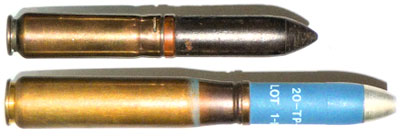Oerlikon SSG 32 / SSG 36 anti-tank rifle

Oerlikon SSG 32
In 1932, the Swiss company “Werkzeugmaschinenfabrik Oerlikon” developed a large-caliber self-loading anti-tank rifle (PTR), which received the index SSG 32 (Schweres Selbtsladen Gewehr 32 - heavy semi-automatic rifle of the 1932 model). This weapon bore a certain resemblance to the Becker automatic aircraft cannon, which was developed and used by the German Air Force during the First World War.
The Oerlikon SSG model 32 anti-tank missiles used 20 mm 20x72 RB cartridges. The pointed projectile of this ammunition was strong enough to penetrate the bulletproof armor of light tanks and armored cars (20 mm at a distance of 100 m).
| SSG 32 | SSG 36 | |
|---|---|---|
| Caliber, mm | 20x72 RB | 20x110 RB |
| Length, mm | 1450 | 1727 |
| Barrel length, mm | 750 | 840 |
| Weight without cartridges, kg | 30.0 | 8.5 |
| Magazine, number of cartridges | 5, 10 | 5, 10 |
| Rate of fire, | ||
| rds/min | 8 - 10 | 8 - 10 |
| Sighting range | ||
| , m | 500 | 500 |
| Muzzle velocity | ||
| , m/s | 555 | 750 |
| Armor penetration, | ||
| (distance, m / | ||
| angle of encounter, deg / | ||
| penetration, mm) | 100 / 90 / 20 | |
| 300 / 90 / 17 | ||
| 500 / 90 / 15 | 100 / 90 / 27 | |
| 300 / 90 / 23 | ||
| 500 / 90 / 19 |
The SSG 32 was reloaded under the influence of recoil force. The gun had a massive spring-loaded bolt and a fixed barrel. The shot occurred at the moment of movement of the bolt forward.
The barrel of the weapon was equipped with a muzzle brake.
The firing mechanism allowed only single fire. The practical rate of fire was 8-10 rounds per minute.
The weapon was fed with ammunition from detachable box magazines attached horizontally to the left. Magazines with a capacity of 5 and 10 rounds were used.
The sights consisted of a mechanical open adjustable sector-type sight and a front sight.
The weapon was mounted on a bipod attached to the front of the barrel. For additional support and fixation of the weapon in a certain position, a folding coulter was mounted under the shoulder rest.
The strong recoil of the weapon was partially compensated by a muzzle brake, a bipod assembly and a shock absorber buffer on the shoulder rest.
Shooting from anti-tank missiles took place as follows: the shooter cocked the handle on the right side of the weapon until it clicked, put the gun on the safety and inserted a magazine with cartridges. After removing the safety, aiming at the target and triggering were carried out. The bolt began to move forward, grabbed the cartridge and the firing pin was activated at the entrance of movement. At this point, the cartridge was not yet completely trapped in the chamber. The energy of the gases slowed down the bolt and pushed it back.
The disadvantage of the gun was the high braking force of the bolt, which caused a strong jump of the weapon, which affected accuracy. This drawback was partially eliminated on a modernized version released in 1936.

Oerlikon SSG 36
In 1936, the Oerlikon SSG 32 was modified to increase efficiency. The new gun was designated SSG 36.
The SSG 36 was redesigned for the more powerful 20 mm 20x110 RB cartridge with a longer case and a more powerful powder charge than the 20x72 RB. The muzzle velocity of the projectile increased by almost 200 meters per second.

The principle of operation of the 1936 model did not change compared to the previous model of 1932, but the bolt became longer and heavier. A more powerful spring and a longer and more massive barrel were used. Improved the firing mechanism. There is an additional safety behind the trigger. The bipod was moved to the front of the receiver and the shock absorber buffer on the shoulder rest was improved.
The gun acquired much greater stability when firing and increased armor penetration (27 mm at a distance of 100 m).

Oerlikon SSG 36
The Oerlikon SSG 36 anti-tank rifle was a fairly reliable and easy-to-maintain weapon. However, it had a strong recoil, and by the late 1930s and early 1940s, it no longer met the requirements for the armor penetration of tanks.
Oerlikon anti-tank rifles were produced in small quantities and, in addition to the Swiss armed forces, were purchased by Finland and Czechoslovakia.